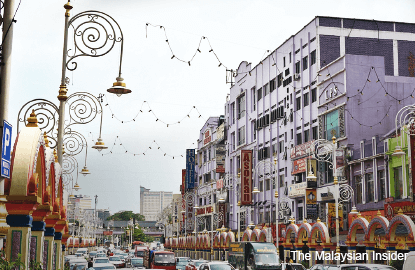
KUALA LUMPUR: Known as Little India, the iconic Brickfields in Kuala Lumpur has evolved from a quiet suburb into the bustling hub it is today.
Brickfields’ dramatic change began in 1996 when Malaysian Resources Corp Bhd made the decision to build the 29ha transit-oriented KL Sentral there.
Today, Brickfields mirrors both the modern and the quaint with skyscrapers, offices, upmarket hotels, residences and a shopping complex on one side of Jalan Tun Sambanthan and traditional shop houses, old quarters and apartments in Jalan Sultan Abdul Samad and Jalan Berhala.
Brickfields Rukun Tetangga chairman SKK Naidu said Brickfields had in recent years begun to lose its identity.
“There are large buildings in Jalan Tun Sambanthan that look nice and modern. But the development and the one-way road system have resulted in a mess on the other side of Brickfields in Jalan Sultan Abdul Samad,” he said.
Naidu said the rapid development had drawn more traffic to Little India, causing chaos on the roads and a host of problems to the local community.
“It is not the Brickfields that I grew up in. Every little thing here needs to be fought for, Vivekenanda Ashram for one, without the community fighting for it, we would have lost an iconic building and a piece of our history,” he said.
In June, The Malaysian Insider reported that the 99-year-old 100 Quarters were being demolished.
MRCB executive vice-president Datuk Dell Akbar Khan said the 12 blocks of former government quarters were being torn down due to safety and security concerns.
However, it was previously reported that the land could be used for a project comprising three blocks of 40-storey towers with a total of 1,350 serviced apartments.
“Even the local community is quickly dwindling as people are moving out. Some are cashing in on the rise in the price of their property, while others finding it too expensive to rent, and some just finding it too congested in Brickfields,” Naidu said.
A theedgeproperty.com analysis of transactions of non-landed residential property in Brickfields found that average values rose 25% in the third quarter of last year from a year ago to RM762 per sq ft.
S Pramasivam, 63, who has run a barber shop in Brickfields for more than 30 years, has personally witnessed how Brickfields has changed since Merdeka in 1957.
“We have come a long way since Merdeka. Even before KL Sentral, there were many developments. PWD (Public Works Department) quarters and KTM (Keretapi Tanah Melayu) quarters were built on the land. The famous Lido theatre is now Public Bank. So much has changed,” he said.
Pramasivam said there were few barber shops then and many came to him for a haircut. Among them was badminton player Rashid Sidek, who was a frequent customer in the mid-1990s.
“It is a different time now. I still have my regulars but many have left Brickfields for other parts.”
Pramasivam is also worried that development may change Brickfields irreversibly.
“New buildings are popping up everywhere. Everything is being developed. Who knows, soon, they may even tear down the building where my shop is to make way for more developments.
The change in Brickfields is for the better, according to Little India Petty Traders’ Association president G Gunasegaran, who said development had brought more business for traders in Brickfields.
Of course there were areas that could be improved, such as parking and traffic congestions, said Gunasegaran.
“The infrastructure is not coping with the traffic, and if the authorities can fix this, Brickfields will be even better,” he said. — The Malaysian Insider
This article first appeared in digitaledge Daily, on September 1, 2015.